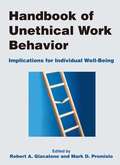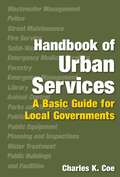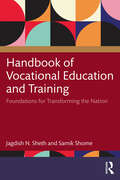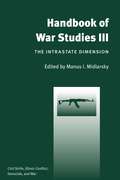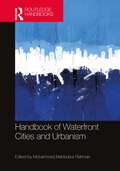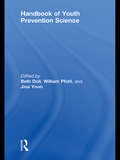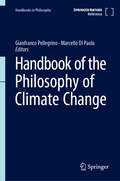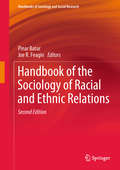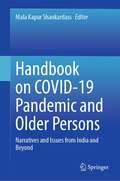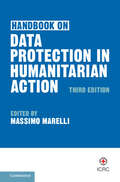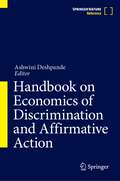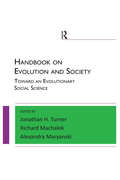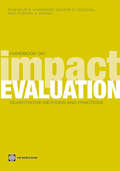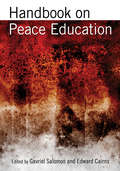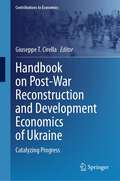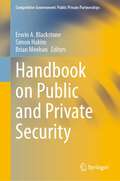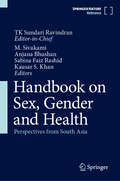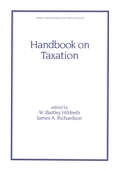- Table View
- List View
Handbook of Unethical Work Behavior: Implications for Individual Well-Being
by Robert A Giacalone Mark D PromisloThis handbook covers the widest possible range of organizational misbehaviors (age, race, and gender discrimination, abuse, bullying, aggression, violence, fraud and corruption), all with an eye toward the effects on individual and organizational health and well-being. It is the first-ever single-source resource on this important topic.
Handbook of Urban Mobilities (Routledge International Handbooks)
by Ole B. JensenThis book offers the reader a comprehensive understanding and the multitude of methods utilized in the research of urban mobilities with cities and ‘the urban’ as its pivotal axis. It covers theories and concepts for scholars and researchers to understand, observe and analyse the world of urban mobilities. The Handbook of Urban Mobilities facilitates the understanding of urban mobilities within a historic conscience of societal transformation. It explores key concepts and theories within the ‘mobilities turn’ with a particular urban framework, as well as the methods and tools at play when empirical, urban mobilities research is undertaken. This book also explores the urban mobilities practices related to commutes; particular modes of moving; the exploration of everyday life and embodied practices as they manifest themselves within urban mobilities; and the themes of power, conflict, and social exclusion. A discussion of urban planning, public control, and governance is also undertaken in the book, wherein the themes of infrastructures, technologies and design are duly considered. With chapters written in an accessible style, this handbook carries timely contributions within the contemporary state of the art of urban mobilities research. It will thus be useful for academics and students of graduate programmes and post-graduate studies within disciplines such as urban geography, political science, sociology, anthropology, urban planning, traffic and transportation planning, and architecture and urban design.
Handbook of Urban Services: Basic Guide for Local Governments
by Charles K. CoeWith conributions from eminent scholars worldwide, this handbook is a "state-of-the-science" summary of the body of knowledge about cultural intelligence--an individual's ability to funtion effectively in situations characterized by cultural diversity--and its relevance for managing diversity both within and across
Handbook of Vocational Education and Training: Foundations for Transforming the Nation
by Jagdish N. Sheth Samik ShomeVocational education and training (VET) are major stepping stones in the development journey of any nation. A carefully structured and implemented VET system ensures skill development and equips the existing and prospective workforce with the necessary technical proficiency, thereby reducing unemployment and increasing productivity. This handbook is designed to provide the readers with a comprehensive understanding of the ways in which VET has been implemented in both highly developed and developing countries around the globe, including Germany, Japan, China, India, and countries in Africa and Latin America, among others. It looks at how VET plays a crucial role in empowering a nation, acts as a comparative advantage, and contributes to nation-building. In the process, it highlights the best practices and fallacies related to VET and showcases how effective vocational training can allow countries to confront existing deficits in employment and decent work. This detailed handbook will be of interest to policymakers, government officials, and corporate executives working in education, education policy, curriculum, teaching and learning, adult education and lifelong learning, and classroom practice. It will also be valuable to technical education students and those working with executive training programmes, public sector enterprises and NGOs related to VET.
Handbook of War Studies III: The Intrastate Dimension
by Manus I. MidlarskyHandbook of War Studies III is a follow-up to Handbook of War Studies I (1993) and II (2000). This new volume collects original work from leading international relations scholars on domestic strife, ethnic conflict, genocide, and other timely topics. Special attention is given to civil war, which has become one of the dominant forms - if not the dominant form - of conflict in the world today.
Handbook of Water and Wastewater Systems Protection
by Simon Hakim Avi Ostfeld Robert M. ClarkFollowing the events of 9/11, the Administrator of the US Environmental Protection Agency created the Water Protection Task Force (WPTF), which identified water and wastewater systems as a major area of vulnerability to deliberate attack. The WPTF suggested that there are steps that can be taken to reduce these vulnerabilities and to make it as difficult as possible for potential saboteurs to succeed. The WPTF recommended that be scrutinized with renewed vigor to secure water and wastewater systems against these possible threats. It also recommended that water and wastewater systems have a response plan in place in the event an act of terrorism occurs. The WPTF identified water distribution networks as an area of special vulnerability and highlighted the need for rapid on-line detection methods that are accurate and have a wide detection range. As a result of these recommendations novel technologies from various fields of science and engineering are now addressing water security issues and water and wastewater utilities are looking for innovative solutions. Once such technologies are available, there will be a rapid implementation process that will present many business opportunities for the private sector. However, in addition to terrorist threats water and wastewater systems are inherently vulnerable to natural disasters such as earthquakes and floods. This volume will address the problems associated with both intended terrorist attacks and natural disasters affecting water or wastewater systems. The book is divided into parts based on the kinds of threats facing water and wastewater systems: (1) a direct attack on water and wastewater infrastructure storage reservoirs, and distribution and collection networks; (2) a cyber attack disabling the functionality of the water and wastewater systems or taking over control of key components which might result in system failures; and (3) a deliberate chemical or biological contaminant injection at one of the water distribution system's nodes. It will examine unique plans, technological and managerial innovations for protecting such systems, and includes descriptions of projects that were implemented to respond to natural disasters. Case studies are presented that discuss existing projects and evaluate their performance, with an emphasis on providing guidelines and techniques that can be implemented by water and wastewater planners and managers to deal with natural and manmade disasters should they occur.
Handbook of Waterfront Cities and Urbanism
by Mohammed Mahbubur RahmanHandbook of Waterfront Cities and Urbanism is the first resource to address cities’ transformations of their coastlines and riverbanks and the resulting effects on environment, culture, and identity in a genuinely global context. Spanning cities from Gdańsk to Georgetown, this reference for design, development, and planning explores the transition of waterfronts from industrial and port zones to crowd-drawing urban spectacles within the frameworks of urban development, economics, ecology, governance, globalization, preservation, and sustainability. A collection of contextual studies, local perspectives, project reviews, and analyses of evolution and emerging trends provides critical insight into the phenomenon of waterfront development and urbanism in cities from the East to the West. Features: Explores the transformation of waterfronts from industrial hubs to urban playgrounds through the lenses of preservation, governance, economics, ecology, and more. Presents chapter-length case studies drawn from cities in China, Bangladesh, Turkey, the United States, Malaysia, the European Union, Egypt, and other countries. Includes contributions from an interdisciplinary team of international scholars and professionals, a much-needed corrective to the historical exclusion of researchers and issues from the Global South. An ideal reference for graduate students, scholars, and professionals in urban planning, architecture, geography, and history, the Handbook of Waterfront Cities and Urbanism deserves to be on the shelf of urban authorities and any internationally minded academic or practitioner in real estate development, water management, preservation, or tourism.
Handbook of Youth Prevention Science
by Beth DollThe Handbook of Youth Prevention Science describes current research and practice in mental health preventive interventions for youth. Traditional prevention research focused on preventing specific disorders, e.g. substance abuse, conduct disorders, or criminality. This produced "silos" of isolated knowledge about the prevention of individual disorders without acknowledging the overlapping goals, strategies, and impacts of prevention programs. This Handbook reflects current research and practice by organizing prevention science around comprehensive systems that reach across all disorders and all institutions within a community. Throughout the book, preventive interventions are seen as complementary components of effective mental health programs, not as replacements for therapeutic interventions. This book is suitable for researchers, instructors and graduate students in the child and adolescent mental health professions: school psychology, school counseling, special education, school social work, child clinical psychology and the libraries serving them. It is also suitable for graduate course work in these fields.
Handbook of the History of Economic Thought
by Jürgen BackhausThis reader in the history of economic thought challenges the assumption that today's prevailing economic theories are always the most appropriate ones. As Leland Yeager has pointed out, unlike the scientists of the natural sciences, economists provide their ideas largely to politicians and political appointees who have rather different incentives that might prevent them from choosing the best economic theory. In this book, the life and work of each of the founders of economics is examined by the best available expert on that founding figure. These contributors present rather novel and certainly not mainstream interpretations of the founders of modern economics. The primary theme concerns the development of economic thought as this emerged in the various continental traditions including the Islamic tradition. These continental traditions differed substantially, both substantively and methodologically, from the Anglo-Saxon orientation that has been dominant in the last century for example in the study of public finance or the very construct of the state itself. This books maps the various channels of continental economics, particularly from the late-18th through the early-20th centuries, explaining and demonstrating the underlying unity amid the surface diversity. In particular, the book emphasizes the writings of John Stuart Mill, his predecessor David Ricardo and his follower Jeremy Bentham; the theory of Marginalism by von Thünen, Cournot, and Gossen; the legacy of Karl Marx; the innovations in developmental economics by Friedrich List; the economic and monetary contributions and "struggle of escape" by John Maynard Keynes; the formidable theory in public finance and economics by Joseph Schumpeter; a reinterpretation of Alfred Marshall; Léon Walras, Heinrich von Stackelberg, Knut Wicksell, Werner Sombart, and Friedrich August von Hayek are each dealt with in their own right.
Handbook of the Philosophy of Climate Change (Handbooks in Philosophy)
by Marcello Di Paola Gianfranco PellegrinoThis Handbook offers a broad yet unified treatment of many philosophical issues connected with climate change, ranging from foundational puzzles to detailed applications. It extends to many branches of philosophy that are relevant to the understanding of the premises and implications of the impacts of climate change on human and nonhuman life on Earth. More specifically, the handbook examines the scientific accounts of climate change as well as its causes. It explores the tools offered by social sciences and humanities to study the societal premises and impacts of climate change as well as delving deeper into the ethical and political issues connected with and resulting from climate change. By doing so, it puts it all in an ecological and historical context. In addition, the book offers solutions to some important philosophical puzzles and problems, and indicates paths of interaction between philosophy and other disciplines. The discussion about climate change and the mitigation/adaptation policies spans many areas and levels – from abstract science and philosophy to current on-the-ground politics. However, climate change is also a great a philosophical puzzle. Indeed, its existential and practical relevance can be thought to largely derive from the philosophical complications it engenders. Climate change is applied philosophy par excellence. Preventing dangerous anthropogenic climate change needs very good philosophy applied to concrete and specific practical issues. Climate change is an area where scholars from very different provenances should cooperate on equal terms, having in view a common, and really important, purpose – contribute to preventing great burdens and even the extinction of humankind and the destruction of hospitable and valuable non-human nature.
Handbook of the Sociology of Racial and Ethnic Relations (Handbooks of Sociology and Social Research)
by Joe R. Feagin Pinar BaturThe study of racial and ethnic relations has become one of the most written about aspects in sociology and sociological research. In both North America and Europe, many "traditional" cultures are feeling threatened by immigrants from Latin America, Africa and Asia. This handbook is a true international collaboration looking at racial and ethnic relations from an academic perspective. It starts from the principle that sociology is at the hub of the human sciences concerned with racial and ethnic relations.
Handbook on COVID-19 Pandemic and Older Persons: Narratives and Issues from India and Beyond
by Mala Kapur ShankardassThis handbook provides an in-depth analysis of the impact of the Covid-19 pandemic on older people across different countries, focusing on important issues affecting ageing societies. It presents an analytical framework of various emerging concerns affecting societies, transforming of social relationships, bringing in of new health problems, including mental health, elder abuse, impact on intergenerational relationships and emotional and psychological matters. It explores the choices of governments to address the arising issues, indicates different community responses and discusses the experiences of older people in handling of problems cropping up, which affect their quality of life in various ways. The book offers readers new dimensions of the issues nations face with possible similar solutions and ways to handle the concerns. The book is valuable for researchers, practitioners, and students pursuing anthropology, sociology, psychology, and gerontology. The book offers many disciplinary international and national perspectives to understand the relationship between the pandemic and older people.
Handbook on Data Protection in Humanitarian Action
by Massimo MarelliThis handbook is a foundational text which offers a comprehensive, accessible analysis of personal data protection law, and its significance to humanitarian organizations. Bringing together years of research on personal data protection principles, it outlines how humanitarian organizations can use these principles to uphold the rights and dignity of the most vulnerable. Reflecting the rapid evolution of new technologies, the handbook provides an in-depth analysis of the impacts of using specific technologies in humanitarian contexts. It raises awareness of the importance of data protection and suggests practical steps that humanitarian organizations can implement to process the personal data that they hold in a responsible manner that complies with personal data protection principles and requirements. With tailored advice and extensive, up-to-date research, this is a vital resource for humanitarian practitioners and lawyers, data protection authorities and researchers working on humanitarian affairs and personal data protection. This title is also available as Open Access on Cambridge Core.
Handbook on Deradicalization and Rehabilitation of Violent Extremist Offenders in Bangladesh (SpringerBriefs in Environment, Security, Development and Peace #41)
by Imtiaz Ahmed Niloy Ranjan Biswas ASM Ali AshrafThis Handbook provides a theory-driven and policy-relevant analysis of terrorist offenders' deradicalization processes. It is the product of a multi-year collaboration between security studies scholars and counterterrorism practitioners. It offers a multidimensional strategy for the physical and cognitive disengagement of terrorists. It also charts a path for the community-based social reintegration of rehabilitated extremist offenders. The Handbook is targeted for both academics and practitioners in the field of counterterrorism. Those specializing in South Asia and the Global South will find this book a useful reference tool to comprehend and design the complex deradicalization processes and transform them into implementable practices.
Handbook on Economics of Discrimination and Affirmative Action
by Ashwini DeshpandeThis Handbook deals with theoretical and empirical evidence on the economics of discrimination and affirmative action across the world, assessed over a variety of social identities, such as caste, race, ethnicity, gender, disability, age, tribal status. It also outlines methodological advances in this area, with plenty of additional references for the interested reader. It combines theoretical frameworks developed in the West with historical writings about discrimination and social justice from primarily Indian philosophers, aspects which are typically not found under one roof. It offers the reader a combination of insights into theories across a range of disciplines, as well as evidence, data –both quantitative and qualitative, in addition to the latest methodological advances in the estimation of discrimination – econometric, experimental, mixed-methods.
Handbook on Evolution and Society: Toward an Evolutionary Social Science
by Jonathan H. Turner Alexandra Maryanski Richard Machalek"Handbook on Evolution and Society" brings together original chapters by prominent scholars who have been instrumental in the revival of evolutionary theorizing and research in the social sciences over the last twenty-five years. Previously unpublished essays provide up-to-date, critical surveys of recent research and key debates. The contributors discuss early challenges posed by sociobiology, the rise of evolutionary psychology, the more conflicted response of evolutionary sociology to sociobiology, and evolutionary psychology. Chapters address the application and limitations of Darwinian ideas in the social sciences. Prominent authors come from a variety of disciplines in ecology, biology, primatology, psychology, sociology, and the humanities. The most comprehensive resource available, this vital collection demonstrates to scholars and students the new ways in which evolutionary approaches, ultimately derived from biology, are influencing the diverse social sciences and humanities.
Handbook on Geopolitics and Security in the Arctic: The High North Between Cooperation and Confrontation (Frontiers in International Relations)
by Joachim WeberAgainst the backdrop of climate change and tectonic political shifts in world politics, this handbook provides an overview of the most crucial geopolitical and security related issues in the Arctic. It discusses established shareholder's policies in the Arctic – those of Russia, Canada, the USA, Denmark, and Norway – as well as the politics and interests of other significant or future stakeholders, including China and India. Furthermore, it explains the economic situation and the legal framework that governs the Arctic, and the claims that Arctic states have made in order to expand their territories and exclusive economic zones. While illustrating the collaborative approach, represented by institutions such as the Arctic council, which has often been described as an exceptional institution in this region, the contributing authors examine potential resource and power conflicts between Arctic nations, due to competing interests. The authors also address topics such as changing alliances between Arctic nations, new sea lines of communication, technological shifts, and eventually the return to power politics in the area. Written by experts on international security studies and the Arctic, as well as practitioners from government institutions and international organizations, the book provides an invaluable source of information for anyone interested in geopolitical shifts and security issues in the High North.
Handbook on Impact Evaluation: Quantitative Methods and Practices
by Shahidur R. Khandker Gayatri B. Koolwal Hussain A. SamadPublic programs are designed to reach certain goals and beneficiaries. Methods to understand whether such programs actually work, as well as the level and nature of impacts on intended beneficiaries, are main themes of this book. Has the Grameen Bank, for example, succeeded in lowering consumption poverty among the rural poor in Bangladesh? Can conditional cash transfer programs in Mexico and Latin America improve health and schooling outcomes for poor women and children? Does a new road actually raise welfare in a remote area in Tanzania, or is it a 'highway to nowhere'? This book reviews quantitative methods and models of impact evaluation. It begins by reviewing the basic issues pertaining to an evaluation of an intervention to reach certain targets and goals. It then focuses on the experimental design of an impact evaluation, highlighting its strengths and shortcomings, followed by discussions on various non-experimental methods. The authors also cover methods to shed light on the nature and mechanisms by which different participants are benefiting from the program. For researchers interested in learning how to use these models with statistical software, the book also provides STATA exercises in the context of evaluating major microcredit programs in Bangladesh, such as the Grameen Bank. The framework presented in this book can be very useful for strengthening local capacity in impact evaluation among technicians and policymakers in charge of formulating, implementing, and evaluating programs to alleviate poverty and underdevelopment.
Handbook on Peace Education
by Gavriel Salomon Edward CairnsThis handbook encompasses a range of disciplines that underlie the field of peace education and provides the rationales for the ways it is actually carried out . The discipline is a composite of contributions from a variety of disciplines ranging from social psychology to philosophy and from communication to political science. That is, peace education is an applied subject which is practiced in differing ways, but must always be firmly based on a range of established empirical disciplines. The volume is structured around contributions from expert scholars in various fields that underpin peace education, plus contributions from experts in applying peace education in a range of settings, all complemented by chapters which deal with issues related to research and evaluation of peace education.
Handbook on Post-War Reconstruction and Development Economics of Ukraine: Catalyzing Progress (Contributions to Economics)
by Giuseppe T. CirellaThis authoritative handbook offers insights into the complexities of post-war reconstruction and development economics in Ukraine. Covering a broad spectrum of topics, from bolstering national security to fostering sustainable economic growth, it offers a comprehensive understanding of the economic dynamics, factors, and practical applications shaping policy and programs.The book explores the multifaceted requirements for enhancing fiscal, economic, and social aspects, including security, education, working conditions, domestic and international policies, and market conditions. Using traditional and innovative analytical tools, it unravels the complex relationship between macroeconomic and microeconomic factors in Ukraine's post-war landscape, charting a path towards economic growth. Key themes within this handbook encompass development data, statistical capacity building, research and knowledge creation, national indicators, and impact evaluation. An indispensable reference for Ukraine's future and a must-read for researchers and policy analysts focused on Eastern European economies, this handbook illuminates the journey from war-torn nations to more prosperous ones.
Handbook on Public Private Partnerships in Transportation, Vol I: Airports, Water Ports, Rail, Buses, Taxis, and Finance (Competitive Government: Public Private Partnerships)
by Erwin A. Blackstone Simon Hakim Robert M. ClarkThis book discusses the role of public-private partnerships (PPPs) in global transportation infrastructure. Seen as a way to provide vital services in an era of shrinking government budgets, public-private partnerships have become an increasingly important part of travel infrastructure worldwide. This book describes and analyzes the structure of various models of PPPs in various countries, evaluating their effectiveness, and drawing policy implications for future use. Written by leading international researchers and practitioners in the transportation field, each chapter is a case study on the adoption, implementation, and outcome of transportation services in different municipalities. Taken together, these diverse case studies provide an integrated framework for evaluating and using PPPs. Providing rigorous empirical analysis of PPPs in transportation, this volume will be of interest to researchers in public administration, political science, and economics as well as practitioners and policymakers involved in establishing and monitoring PPPs in transportation.
Handbook on Public Private Partnerships in Transportation, Vol II: Roads, Bridges, and Parking (Competitive Government: Public Private Partnerships)
by Erwin A. Blackstone Simon Hakim Robert M. ClarkSecond in a two-volume set, this book discusses the role of public-private partnerships (PPPs) in global transportation infrastructure, specifically focusing on roads, bridges, and parking. To provide vital services in an era of shrinking government budgets, public-private partnerships have become an increasingly important part of travel infrastructure worldwide. This book describes and analyses the structure of various models of PPPs in several countries, evaluating their effectiveness, and drawing policy implications for future use. The chapters were written by leading international researchers and practitioners in the transportation field where each chapter is a case study on the adoption, implementation, and outcome of transportation services. Taken together, these diverse case studies provide an integrated framework for evaluating, using PPPs, and suggesting policy implications to both the public and the private sectors in transportation. Providing rigorous empirical analysis of PPPs in transportation, this volume will be of interest to researchers in public administration, political science, public choice, and economics as well as practitioners and policymakers involved in establishing and monitoring PPPs in transportation.
Handbook on Public and Private Security (Competitive Government: Public Private Partnerships)
by Erwin A. Blackstone Simon Hakim Brian MeehanThis Handbook discusses the use of public-private partnerships in law enforcement and security. Written by international experts across multiple disciplines, chapters include case studies and cross-sectional industry-wide studies of private security performance in comparison with public police and collaborated experiences of the two sectors. The Handbook uses existing experiences and public economics to suggest how to improve security and social welfare through greater competition and cooperation between public and private security. This volume provides an integrated framework to assist policymakers in both public and private agencies. This Handbook will be an important reference for scholars in public economics, public administration, criminology, and criminal justice, as well as professionals and policymakers in the public and private sectors.
Handbook on Sex, Gender and Health: Perspectives from South Asia
by Tk Sundari RavindranThis Handbook is the first of its kind addressing gender issues in health in five countries of the South Asian Region, namely: Bangladesh, India, Pakistan and Sri Lanka. Adopting a social determinant of health perspective and an intersectionality and diversity lens, the Handbook illustrates the multi-layered complexities of gender, health, and well-being from the diverse perspectives and lived experiences in different South Asian countries. It includes studies on under-researched and often invisible marginalized populations, such as LGBTQI populations, urban poor, persons living with disability, migrant and conflict-affected populations. It represents the voices of the elderly, adolescents, and young people. It goes beyond analyzing the problem of gender inequities in health, and present examples of gender-transformative policies, programmes and social movement action. It is an essential resource for researchers, policy-makers, students in public health and community-based organizations involvedin research, policies, or programs related to sex work, public health, social justice and gender-based violence.
Handbook on Taxation (Public Administration And Public Policy Ser. #72)
by W. Bartley Hildreth James A. RichardsonA groundbreaking reference, this book provides a comprehensive review of tax policy from political, legal, constitutional, administrative, and economic perspectives. A collection of writings from over 45 prominent tax experts, it charts the influence of taxation on economic activity and economic behavior. Featuring over 2400 references, tables, equations, and drawings, the book describes how taxes affect individual and business behavior, shows how taxes operate as work and investment incentives, explains how tax structures impact different income groups, weighs the balanced use of sales, property, and personal income taxes, traces the influence of recent tax changes, and more.
